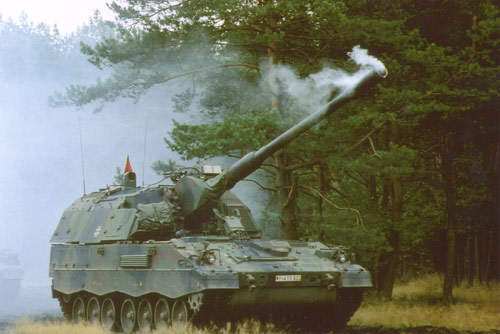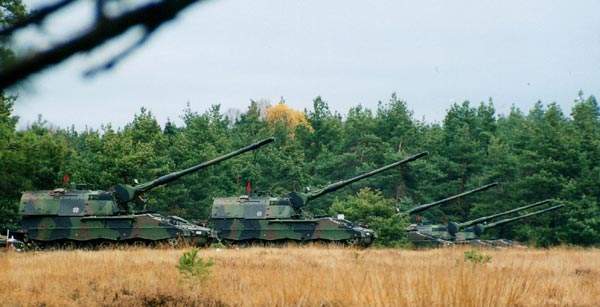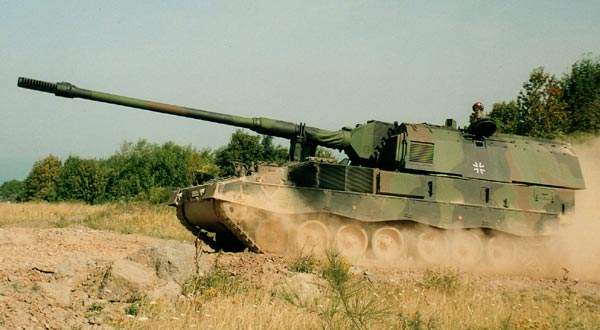The PzH 2000 (Panzerhaubitze 2000) is the 155mm self-propelled howitzer developed by Krauss-Maffei Wegmann (KMW) together with the main subcontractor Rheinmetall Landsysteme for the German Army.
KMW received a contract in 1996 for production of 185 units. The first system was delivered in July 1998 and deliveries for this batch are complete. Rheinmetall (formerly MaK) delivers the complete chassis for all series vehicles.
In May 2001, during test firings for the Hellenic Army, the PzH 2000 fired 20 rounds all to ranges exceeding 40km (41.8km maximum). The ranges were achieved using M2000BB Assegai shells from Naschem / Denel of South Africa, in combination with the Rheinmetall DM 72 modular charge system. In November 2002, in live firings in Sweden, a similar range was achieved with Rheinmetall’s new long-range RH 40 BB ammunition, also fired with the modular charge system.
A PzH 2000 howitzer turret has been mounted on the deck of German Navy F124 frigate, Hamburg, as a demonstration of the feasibility of the system for naval applications. The concept is called MONARC and requires a flexible elastic mounting.
PzH 2000 howitzer orders and deliveries
Total German Army requirement has been reduced from around 450 units to 260. PzH 2000 has also been selected by the Italian, Dutch and Greek Armies. The Greek Army has 24 systems, delivered between July 2003 and June 2004.
A German / Italian co-production programme with Consorzio Iveco-Oto Melara is providing the 70 units for the Italian Army. KMW delivered two units in 2002. First deliveries of the remaining 68 from Consorzio Iveco-Oto Melara took place in May 2007. The system entered service with the Italian Army in June 2007 and achieved initial operating capability in October 2008. Final deliveries are scheduled for 2009.
The Dutch army signed a contract for the procurement of for 57 units, later reduced to 39 units and deliveries are underway. The surplus 18 units (not yet built) were offered to the Australian Army but were declined.
In September 2006, the PZH 2000 completed its first live-fire combat mission with the Dutch Army in Afghanistan, as part of Operation Medusa. In operations against the Taliban, three PZH 2000 provided fire support at a range of more than 30km.
PzH 2000 155mm L52 howitzer gun
The electrical gun control system, supplied by ESW Extel Systems Wedel, comprises the automatic elevating and traversing drives with semi-automatic back-up, direct laying with electrical instrument control and manual control.
The 155mm L52 gun of the PzH 2000 was developed by Rheinmetall DeTec. The barrel length is 52 calibre and chamber volume is 23l. The gun has a chromium-plated barrel and semi-automatic lifting breech block with integrated 32-round standard primer magazine.
Gun parameters such as chamber temperature are monitored automatically. The PzH 2000 is equipped with a fully automatic shell loading system with ammunition management system.
The chromium-plated barrel is 8m long and is fitted with a slotted muzzle brake which gives increased muzzle velocity and reduces the level of muzzle flash.
The wedge-type breech block is integrated with an exchangeable primer magazine fitted with an endless conveyer for automatic primer transportation, loading and unloading.
Rheinmetall DeTec has also developed a six-zone modular propelling charge system (MTLS), the DM72, which provides for faster handling, less wear on the gun, lower sensitivity to ignition hazards and improved range. In the PzH 2000, up to six MTLS modules form the propelling charge. The maximum range of the L52 gun using the maximum MTLS charges is 30km with the standard L15A2 round and up to 40km with assisted projectiles.
The gun positioning and laying system is produced by Honeywell Maintal and mounted on the gun cradle. The system automatically determines gun direction, position and elevation above sea level. The integrated global positioning system (GPS) receiver and the vehicle’s motor sensors form the hybrid navigation system of the PzH 2000.
Automatic shell-loading system
The PzH 2000 automatic shell-loading system can handle 60 rounds of 155mm ammunition. The shells are picked up from the back of the vehicle and automatically stowed in the 60-round magazine in the centre of the chassis.
The shell-loading system is driven by brushless electric servo motors supplied by MOOG. The automatic shell loading system has pneumatically driven flick rammer and automatic digital control, ammunition supply management and inductive fuze setting.
This provides rates of fire of three rounds in under ten seconds and loading of 60 shells by two operators within 12 minutes, including the collation of ammunition data.
The firing rate of the PzH 2000 was 12 rounds in 59.74 seconds, and 20 rounds in one minute 47 seconds, during firing tests in October 1997 with an improved autoloader. The muzzle velocity is determined automatically by means of a radar sensor and is used in the fire control computation.
Fire control and observation
The PzH 2000 can use an automatic mode of operation including the data radio link with an external command and control system. The autonomous fire control functions are controlled by an on-board MICMOS computer supplied by EADS (formerly DaimlerChrysler Aerospace). Using the automatic mode, target engagements can be carried out by a crew of two. Using the fire control data provided by the ballistics computer, the gun is automatically laid and relayed during the mission.
PZH 2000 completed its first live-fire combat mission with the Dutch Army in Afghanistan.”
Various backup modes are available which guarrantee system sustainability in case of a component failure. As the lowest backup mode, an optical mechanical backup sytem is available.
The commander has a Leica PERI-RTNL 80 panoramic periscope, which is used in under-armour operations and for target designation in direct laying engagements. PERI-RTNL 80 has day and night vision channels and a laser rangefinder. The gunner is equipped with a Leica PzF TN 80 day and night direct fire sight for direct laying of the gun.
Propulsion
The 736kW powerpack of the PzH 2000 is mounted at the front of the hull and consists of an eight-cylinder direct-injection, supercharged MTU MT881 Ka-500 diesel engine with a four-speed Renk HSWL 284 C gearbox. Three fuel tanks provide a 420km cruise range.











